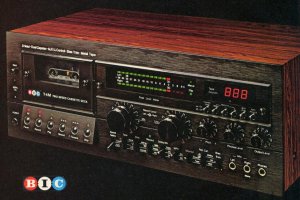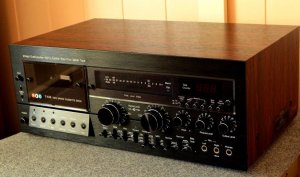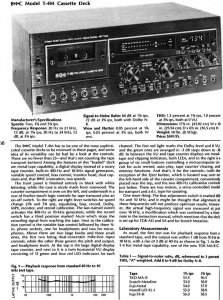Jeg tenkte at litt,(det ble mer enn det jeg trodde) informasjon om de forskjellige hodetypene kan være av interesse. Og Masanori-San er selvfølgelig også en Sonymann. Han var med å utvikle tape og tapeutstyr hos Sony frem til 2006.

Masanori Kimizuka
Chief Survey Officer, Center of the History of Japanese Industrial Technology, National Museum of Nature and Science, Tokyo
Ferrite Heads;
The Compact Cassette started out using ferric oxide tape. As these tapes became more widely used, it became a major challenge to solve the quality performance issue resulting from narrow track width and slow tape speed. In the late 1960s, stereo records, which were already firmly established as a music medium, improved greatly in sound quality due to improvements in recording and cutting technology, creating an even greater demand to improve the sound quality of consumer tape recorders. While development continued on high-performance open-reel machines such as studio recorders, this was increasingly heavy-duty equipment for analogue recording and therefore highly priced. Naturally, this resulted in a greater demand in the home audio and car audio markets for a small-scale, affordable machine that could record and play music on Compact Cassettes. As discussed in Section 8.2, researchers worked on improving the magnetic substance on tape, creating chrome tape in 1970. This tape was superior in a wide range of applications and succeeded in expanding the existing recording and playback bandwidth of 10kHz to around 15kHz, which could comfortably be called Hi-Fi. In terms of compatibility, a new “Chrome Position” (later Type-II) was defined, with a highfrequency playback time constant changed from 120μs to 70μs to match the rise in high-frequency sensitivity. While the greater recording and playback performance of chrome tape played a major part in Compact Cassette machines being accepted as audio equipment, the surface of the tape was harder than ferric oxide tape and caused problems with wear on the heads. To solve this problem, developers brought out an abrasion-resistant ferrite head. Since ferrite is made of compression-moulded powder, it has relatively low manufacturing costs. It forms a hard core material following sintering, but this is easy to grind or cut and therefore easy to achieve dimensional accuracy. As well as being very hard and resistant to wear, ferrite heads also offer a very dimensionally stable gap, with glass layers fused between layers of ground core material. They maintain their initial properties for a very long time and are extremely stable even with changes in temperature and humidity Sony had used ferrite heads in open-reel machines from a very early stage. It used ferrite not only for the core material, but also the entire contact surface of the head, including the dummy segment. This rugged and highly abrasion-resistant head was called the “F&F Head" and also became widely used for Compact Cassettes.
Sendust Heads for Metal Tape;
Metal tape appeared in 1978 at the onset of the digital audio era. This tape was the music tape trump card for the Compact Cassette, able to record and play back sounds that required a high resolution and a large dynamic range, like computer music. While it was understood that metal tape had groundbreakingly superior magnetic properties because it used a magnetic substance of metal powder rather than oxide, this contravened the Compact Cassette policy of “maintaining compatibility”. In short, metal tape used a strongly magnetic substance. Compared in terms of coercive force (saturation flux density) Hc and maximum residual magnetisation Br, the values for the existing chrome (cobalt) music tape were in the vicinity of Hc=600-700Oe, Br=1500G, while the values for metal tape were almost double at Hc=1000Oe, Br=3000G. Hc represents the high frequency recording level (the quality of the high-frequency response) as well as the ease of erasing or the strength of the magnetic field required for magnetisation. The ferric oxide tape first used in Compact Cassettes had an Hc of 350-400Oe. While this value was higher for chrome tape, the existing heads were still adequate for erasing and recording. However, to record at full capacity on Hc=1000Oe metal tape required a stronger magnetic force and a greater bias current in the head. Since the existing head materials (permalloy or ferrite) had a low saturation flux density, any increase in current flowing through them would simply convert to heat rather than provide any effective increase in magnetic flux. Likewise, there was a fatal compatibility f law for erasing, as the existing erase heads would not erase the tape. A discussion commenced on whether or not to change the high frequency time constant for chrome tape from 70μs to 50 or 35μs to make a marked improvement in high-frequency response during playback. One opinion said that the latest technology should be actively incorporated, because fussing over standards and compatibility prevented technological progress, but this meant that the compatibility that was such an important factor in the Compact Cassette would be likely to come undone. However, the latest improvements in performance were sought after in the music scene and could not be ignored. The EIAJ (now JEITA) formulated an international standard in a short space of time with the help of international organisations such as IEC and metal tape Compact Cassettes were introduced. The playback time constant was set at 70μs, the same as for chrome tape. Although the compatibility policy had been closely adhered to for playback, such as maintaining playback on existing machines, a new head (with more efficient materials and design to supress heat and prevent saturation even with a high bias current) was absolutely necessary for recording. While ferrite was used in large quantities in highperformance heads due to its superior abrasion-resistance and the ease and low cost of manufacture and production, it was unsuitable for metal tape due to its low saturation flux density of around 5000G. Sendust gained much attention at this stage. Sendust is an iron-aluminium-silicon alloy invented in 1935 by Dr. Hakaru Masumoto and others at the Tohoku University Institute for Materials Research and used as a magnetic powder core before ferrite was discovered. Although it has superior magnetic properties and has cost benefits due to the abundance of raw materials for it, it has limited uses as it is extremely hard and brittle as a metal (alloy) and difficult to roll out like permalloy. Nevertheless, it gained immediate attention with the advent of metal tape. The worst characteristic of Sendust was its difficulty in processing. While vacuum-melted Sendust ingots were cheap, it was expensive to grind and polish them to make heads. Usually, heads had a laminated structure, made up of ground and polished cores 0.2-0.3mm thick. This thickness was a compromise to keep processing costs down; even thinner layers would have been better for highfrequency response. Various attempts were trialled to make a thinner product, such as the method of melting at high temperatures and then rapidly cooling the alloy in ribbons (ribbon Sendust) or an attempt at rolling the alloy, but it was not suitable for mass head production due to the difficulty in handling the brittle ribbon. One possible method to curb high-frequency loss was the composite S&F Head, with the tip of the head made out of a small block of Sendust, thus making the gap area highly magnetic, while the rest, which did not need to be so strongly magnetic, was made out of ferrite, which has hardly any high-frequency loss. The gap area had more or less the same structure as that of a ferrite head (Fig. 9.10), with the abrasion-resistance of Sendust rivalling that of ferrite. The product was welcomed as a highly reliable, long-life device. Sony, Matsushita and other companies made this type of head; these were widely used in high-performance cassette tape recorders from the metal-tape era onwards.
Adoption of
Amorphous Alloy Head Material.
Although a lot of Sendust was used in heads for metal tape, its saturation flux density was slightly reduced, as other elements such chrome and molybdenum were being added to it to increase its durability as an audio head. While successive studies were made on how to improve it by modifying the type or amount of additives, it was impossible to achieve a saturation flux density any higher than 10,000G. Amorphous alloys emerged as a more effective head material that could transcend this limitation. Non-crystalline amorphous alloys differed in various ways from existing metals with a crystalline lattice structure. When metals melt at high temperature, they have a completely random arrangement of atoms; if they are rapidly cooled, they retain this property even at normal temperatures, thus forming an amorphous alloy. The cooling rate to achieve this is around 10,000-1,000,000ºC/s. In practice, amorphous alloys are made by pouring molten metal from a fine nozzle over a cooling roller rotating at high speed, thus creating a ribbon. At around 30-50μm, this ribbon is of a suitable thickness for use as a head material; it is easy to make into a laminate core by layering it. Soft magnetic amorphous alloys are made from a combination of ferromagnetic metals such as iron, cobalt and nickel, and metalloids necessary for amorphisation, such as phosphorus, carbon, boron and silicon. Harder than ferrite at Hv=800+ and with the same or slightly higher abrasion-resistance than Sendust, they are perfectly suitable material for audio heads. The higher performance amorphous heads took over from Sendust heads, first used in high-end machines such as three-head decks, then in other devices competing for high sound quality.






